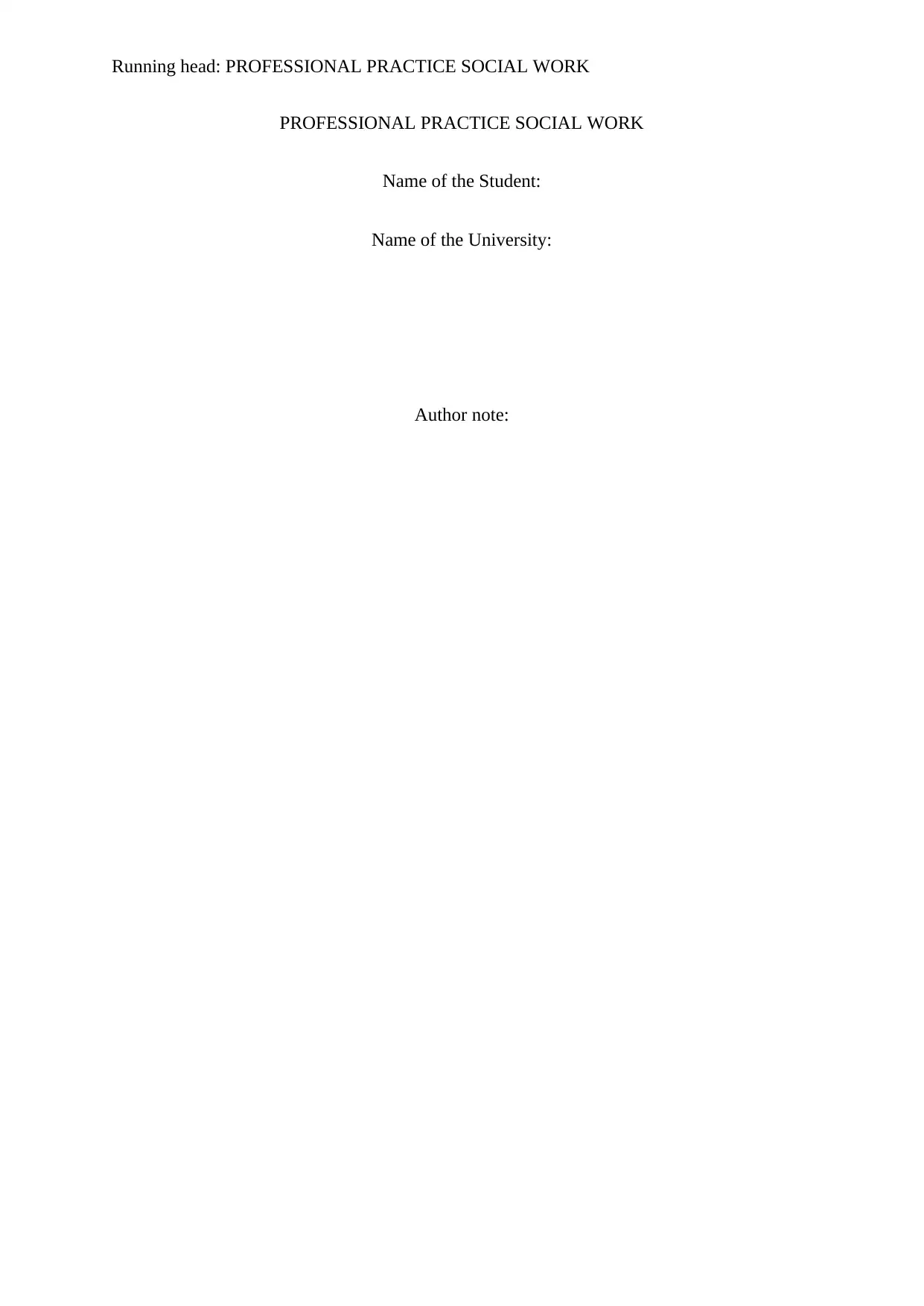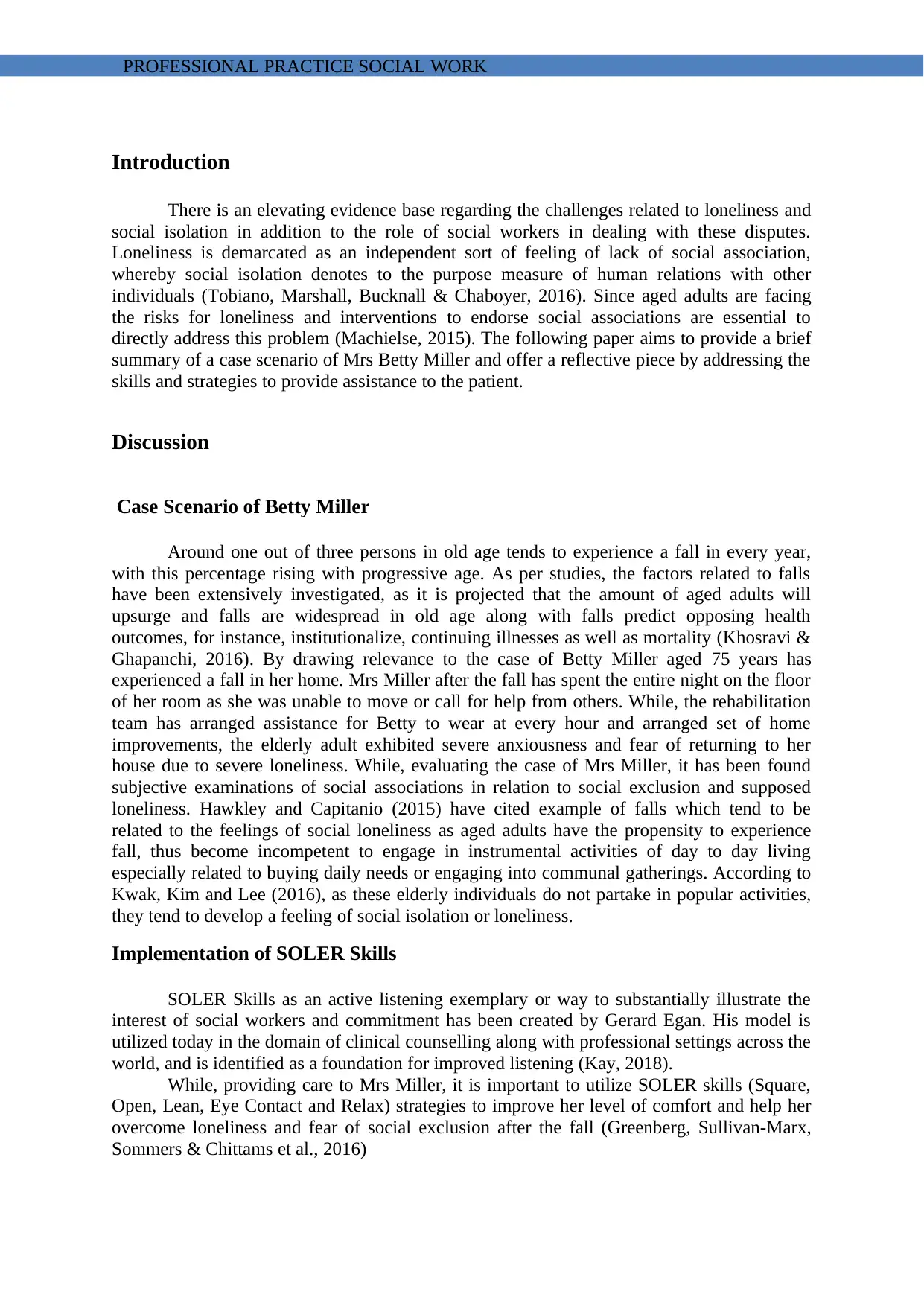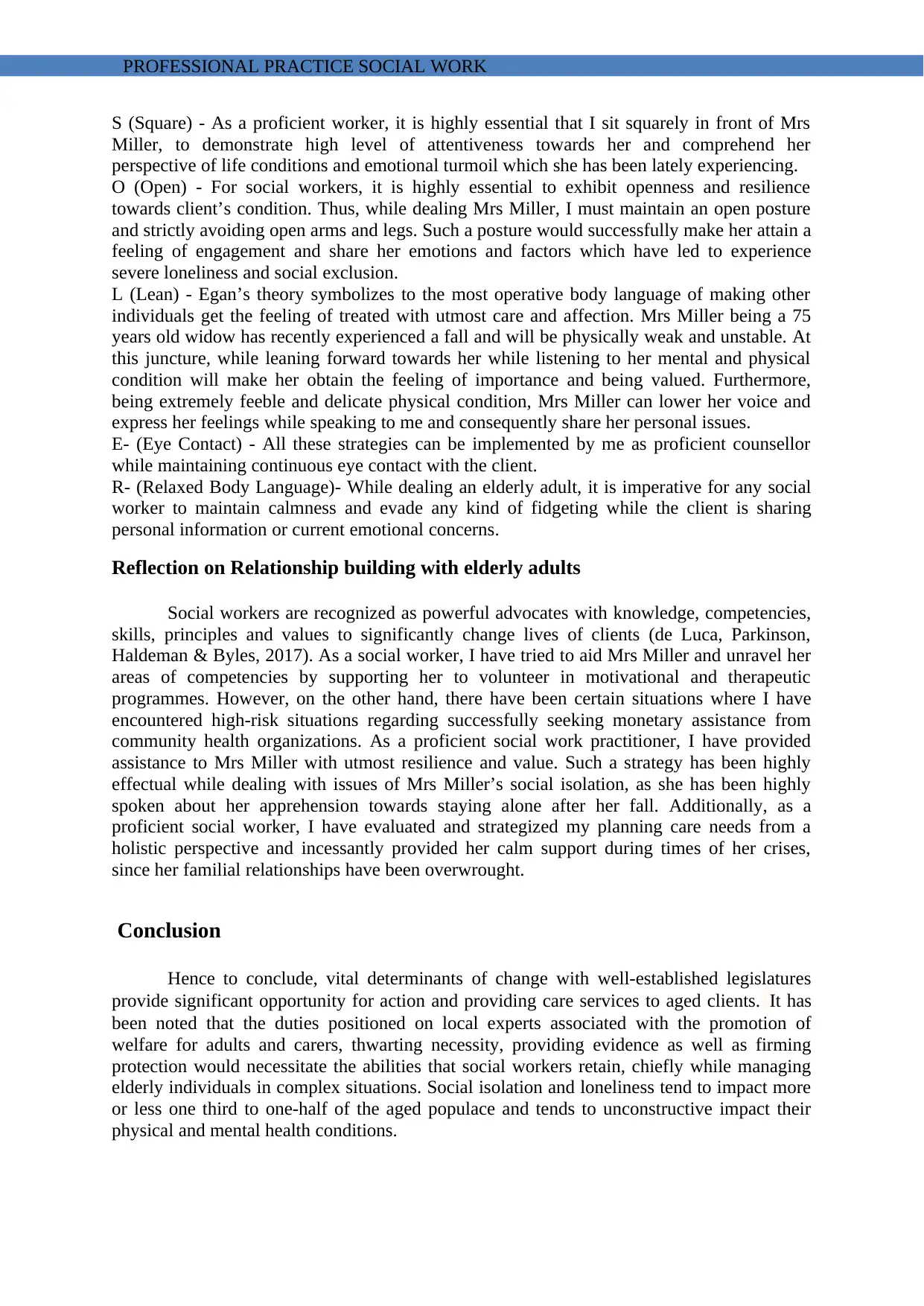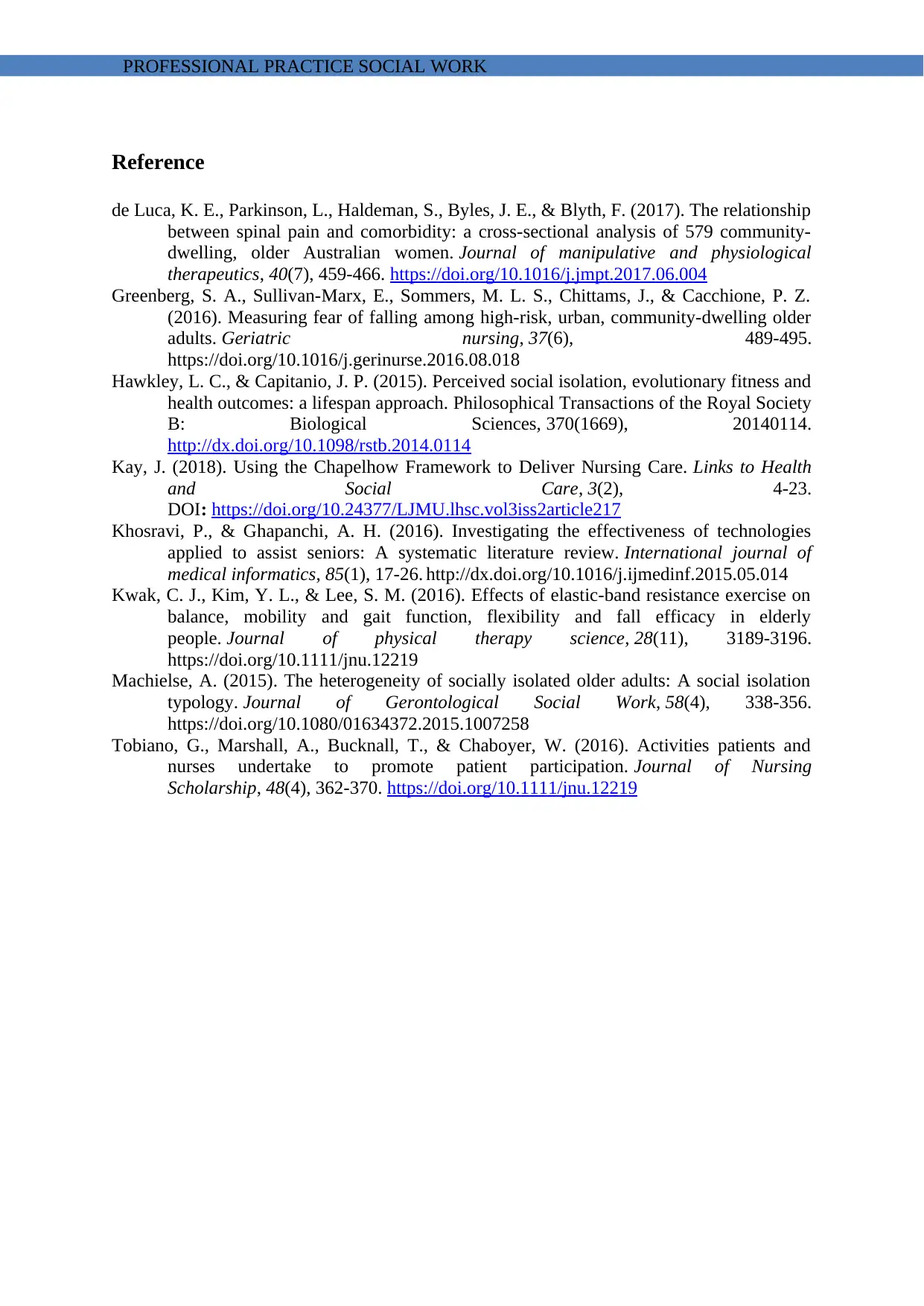SWSP1023 Professional Practice: Betty Miller Case Study and Reflection
VerifiedAdded on 2022/10/01
|4
|1573
|118
Report
AI Summary
This report presents a case study of Mrs. Betty Miller, a 75-year-old woman experiencing loneliness and social isolation after a fall. The report delves into the challenges faced by elderly individuals in such situations, emphasizing the role of social workers in providing support and intervention. It explores the application of SOLER skills (Square, Open, Lean, Eye contact, Relax) as a framework for active listening and effective communication to build rapport and address the client's emotional needs. The report also reflects on the importance of non-verbal communication and highlights strategies for relationship building with elderly adults, considering the complexities of their situations and potential high-risk scenarios. The conclusion emphasizes the significance of social workers' abilities in managing complex cases, particularly in addressing social isolation and its impact on the physical and mental health of the aged population. The report provides a detailed analysis of the case, referencing relevant literature to support the discussion and recommendations for practice.

Running head: PROFESSIONAL PRACTICE SOCIAL WORK
PROFESSIONAL PRACTICE SOCIAL WORK
Name of the Student:
Name of the University:
Author note:
PROFESSIONAL PRACTICE SOCIAL WORK
Name of the Student:
Name of the University:
Author note:
Paraphrase This Document
Need a fresh take? Get an instant paraphrase of this document with our AI Paraphraser

PROFESSIONAL PRACTICE SOCIAL WORK
Introduction
There is an elevating evidence base regarding the challenges related to loneliness and
social isolation in addition to the role of social workers in dealing with these disputes.
Loneliness is demarcated as an independent sort of feeling of lack of social association,
whereby social isolation denotes to the purpose measure of human relations with other
individuals (Tobiano, Marshall, Bucknall & Chaboyer, 2016). Since aged adults are facing
the risks for loneliness and interventions to endorse social associations are essential to
directly address this problem (Machielse, 2015). The following paper aims to provide a brief
summary of a case scenario of Mrs Betty Miller and offer a reflective piece by addressing the
skills and strategies to provide assistance to the patient.
Discussion
Case Scenario of Betty Miller
Around one out of three persons in old age tends to experience a fall in every year,
with this percentage rising with progressive age. As per studies, the factors related to falls
have been extensively investigated, as it is projected that the amount of aged adults will
upsurge and falls are widespread in old age along with falls predict opposing health
outcomes, for instance, institutionalize, continuing illnesses as well as mortality (Khosravi &
Ghapanchi, 2016). By drawing relevance to the case of Betty Miller aged 75 years has
experienced a fall in her home. Mrs Miller after the fall has spent the entire night on the floor
of her room as she was unable to move or call for help from others. While, the rehabilitation
team has arranged assistance for Betty to wear at every hour and arranged set of home
improvements, the elderly adult exhibited severe anxiousness and fear of returning to her
house due to severe loneliness. While, evaluating the case of Mrs Miller, it has been found
subjective examinations of social associations in relation to social exclusion and supposed
loneliness. Hawkley and Capitanio (2015) have cited example of falls which tend to be
related to the feelings of social loneliness as aged adults have the propensity to experience
fall, thus become incompetent to engage in instrumental activities of day to day living
especially related to buying daily needs or engaging into communal gatherings. According to
Kwak, Kim and Lee (2016), as these elderly individuals do not partake in popular activities,
they tend to develop a feeling of social isolation or loneliness.
Implementation of SOLER Skills
SOLER Skills as an active listening exemplary or way to substantially illustrate the
interest of social workers and commitment has been created by Gerard Egan. His model is
utilized today in the domain of clinical counselling along with professional settings across the
world, and is identified as a foundation for improved listening (Kay, 2018).
While, providing care to Mrs Miller, it is important to utilize SOLER skills (Square,
Open, Lean, Eye Contact and Relax) strategies to improve her level of comfort and help her
overcome loneliness and fear of social exclusion after the fall (Greenberg, Sullivan-Marx,
Sommers & Chittams et al., 2016)
Introduction
There is an elevating evidence base regarding the challenges related to loneliness and
social isolation in addition to the role of social workers in dealing with these disputes.
Loneliness is demarcated as an independent sort of feeling of lack of social association,
whereby social isolation denotes to the purpose measure of human relations with other
individuals (Tobiano, Marshall, Bucknall & Chaboyer, 2016). Since aged adults are facing
the risks for loneliness and interventions to endorse social associations are essential to
directly address this problem (Machielse, 2015). The following paper aims to provide a brief
summary of a case scenario of Mrs Betty Miller and offer a reflective piece by addressing the
skills and strategies to provide assistance to the patient.
Discussion
Case Scenario of Betty Miller
Around one out of three persons in old age tends to experience a fall in every year,
with this percentage rising with progressive age. As per studies, the factors related to falls
have been extensively investigated, as it is projected that the amount of aged adults will
upsurge and falls are widespread in old age along with falls predict opposing health
outcomes, for instance, institutionalize, continuing illnesses as well as mortality (Khosravi &
Ghapanchi, 2016). By drawing relevance to the case of Betty Miller aged 75 years has
experienced a fall in her home. Mrs Miller after the fall has spent the entire night on the floor
of her room as she was unable to move or call for help from others. While, the rehabilitation
team has arranged assistance for Betty to wear at every hour and arranged set of home
improvements, the elderly adult exhibited severe anxiousness and fear of returning to her
house due to severe loneliness. While, evaluating the case of Mrs Miller, it has been found
subjective examinations of social associations in relation to social exclusion and supposed
loneliness. Hawkley and Capitanio (2015) have cited example of falls which tend to be
related to the feelings of social loneliness as aged adults have the propensity to experience
fall, thus become incompetent to engage in instrumental activities of day to day living
especially related to buying daily needs or engaging into communal gatherings. According to
Kwak, Kim and Lee (2016), as these elderly individuals do not partake in popular activities,
they tend to develop a feeling of social isolation or loneliness.
Implementation of SOLER Skills
SOLER Skills as an active listening exemplary or way to substantially illustrate the
interest of social workers and commitment has been created by Gerard Egan. His model is
utilized today in the domain of clinical counselling along with professional settings across the
world, and is identified as a foundation for improved listening (Kay, 2018).
While, providing care to Mrs Miller, it is important to utilize SOLER skills (Square,
Open, Lean, Eye Contact and Relax) strategies to improve her level of comfort and help her
overcome loneliness and fear of social exclusion after the fall (Greenberg, Sullivan-Marx,
Sommers & Chittams et al., 2016)

PROFESSIONAL PRACTICE SOCIAL WORK
S (Square) - As a proficient worker, it is highly essential that I sit squarely in front of Mrs
Miller, to demonstrate high level of attentiveness towards her and comprehend her
perspective of life conditions and emotional turmoil which she has been lately experiencing.
O (Open) - For social workers, it is highly essential to exhibit openness and resilience
towards client’s condition. Thus, while dealing Mrs Miller, I must maintain an open posture
and strictly avoiding open arms and legs. Such a posture would successfully make her attain a
feeling of engagement and share her emotions and factors which have led to experience
severe loneliness and social exclusion.
L (Lean) - Egan’s theory symbolizes to the most operative body language of making other
individuals get the feeling of treated with utmost care and affection. Mrs Miller being a 75
years old widow has recently experienced a fall and will be physically weak and unstable. At
this juncture, while leaning forward towards her while listening to her mental and physical
condition will make her obtain the feeling of importance and being valued. Furthermore,
being extremely feeble and delicate physical condition, Mrs Miller can lower her voice and
express her feelings while speaking to me and consequently share her personal issues.
E- (Eye Contact) - All these strategies can be implemented by me as proficient counsellor
while maintaining continuous eye contact with the client.
R- (Relaxed Body Language)- While dealing an elderly adult, it is imperative for any social
worker to maintain calmness and evade any kind of fidgeting while the client is sharing
personal information or current emotional concerns.
Reflection on Relationship building with elderly adults
Social workers are recognized as powerful advocates with knowledge, competencies,
skills, principles and values to significantly change lives of clients (de Luca, Parkinson,
Haldeman & Byles, 2017). As a social worker, I have tried to aid Mrs Miller and unravel her
areas of competencies by supporting her to volunteer in motivational and therapeutic
programmes. However, on the other hand, there have been certain situations where I have
encountered high-risk situations regarding successfully seeking monetary assistance from
community health organizations. As a proficient social work practitioner, I have provided
assistance to Mrs Miller with utmost resilience and value. Such a strategy has been highly
effectual while dealing with issues of Mrs Miller’s social isolation, as she has been highly
spoken about her apprehension towards staying alone after her fall. Additionally, as a
proficient social worker, I have evaluated and strategized my planning care needs from a
holistic perspective and incessantly provided her calm support during times of her crises,
since her familial relationships have been overwrought.
Conclusion
Hence to conclude, vital determinants of change with well-established legislatures
provide significant opportunity for action and providing care services to aged clients. It has
been noted that the duties positioned on local experts associated with the promotion of
welfare for adults and carers, thwarting necessity, providing evidence as well as firming
protection would necessitate the abilities that social workers retain, chiefly while managing
elderly individuals in complex situations. Social isolation and loneliness tend to impact more
or less one third to one-half of the aged populace and tends to unconstructive impact their
physical and mental health conditions.
S (Square) - As a proficient worker, it is highly essential that I sit squarely in front of Mrs
Miller, to demonstrate high level of attentiveness towards her and comprehend her
perspective of life conditions and emotional turmoil which she has been lately experiencing.
O (Open) - For social workers, it is highly essential to exhibit openness and resilience
towards client’s condition. Thus, while dealing Mrs Miller, I must maintain an open posture
and strictly avoiding open arms and legs. Such a posture would successfully make her attain a
feeling of engagement and share her emotions and factors which have led to experience
severe loneliness and social exclusion.
L (Lean) - Egan’s theory symbolizes to the most operative body language of making other
individuals get the feeling of treated with utmost care and affection. Mrs Miller being a 75
years old widow has recently experienced a fall and will be physically weak and unstable. At
this juncture, while leaning forward towards her while listening to her mental and physical
condition will make her obtain the feeling of importance and being valued. Furthermore,
being extremely feeble and delicate physical condition, Mrs Miller can lower her voice and
express her feelings while speaking to me and consequently share her personal issues.
E- (Eye Contact) - All these strategies can be implemented by me as proficient counsellor
while maintaining continuous eye contact with the client.
R- (Relaxed Body Language)- While dealing an elderly adult, it is imperative for any social
worker to maintain calmness and evade any kind of fidgeting while the client is sharing
personal information or current emotional concerns.
Reflection on Relationship building with elderly adults
Social workers are recognized as powerful advocates with knowledge, competencies,
skills, principles and values to significantly change lives of clients (de Luca, Parkinson,
Haldeman & Byles, 2017). As a social worker, I have tried to aid Mrs Miller and unravel her
areas of competencies by supporting her to volunteer in motivational and therapeutic
programmes. However, on the other hand, there have been certain situations where I have
encountered high-risk situations regarding successfully seeking monetary assistance from
community health organizations. As a proficient social work practitioner, I have provided
assistance to Mrs Miller with utmost resilience and value. Such a strategy has been highly
effectual while dealing with issues of Mrs Miller’s social isolation, as she has been highly
spoken about her apprehension towards staying alone after her fall. Additionally, as a
proficient social worker, I have evaluated and strategized my planning care needs from a
holistic perspective and incessantly provided her calm support during times of her crises,
since her familial relationships have been overwrought.
Conclusion
Hence to conclude, vital determinants of change with well-established legislatures
provide significant opportunity for action and providing care services to aged clients. It has
been noted that the duties positioned on local experts associated with the promotion of
welfare for adults and carers, thwarting necessity, providing evidence as well as firming
protection would necessitate the abilities that social workers retain, chiefly while managing
elderly individuals in complex situations. Social isolation and loneliness tend to impact more
or less one third to one-half of the aged populace and tends to unconstructive impact their
physical and mental health conditions.
⊘ This is a preview!⊘
Do you want full access?
Subscribe today to unlock all pages.

Trusted by 1+ million students worldwide

PROFESSIONAL PRACTICE SOCIAL WORK
Reference
de Luca, K. E., Parkinson, L., Haldeman, S., Byles, J. E., & Blyth, F. (2017). The relationship
between spinal pain and comorbidity: a cross-sectional analysis of 579 community-
dwelling, older Australian women. Journal of manipulative and physiological
therapeutics, 40(7), 459-466. https://doi.org/10.1016/j.jmpt.2017.06.004
Greenberg, S. A., Sullivan-Marx, E., Sommers, M. L. S., Chittams, J., & Cacchione, P. Z.
(2016). Measuring fear of falling among high-risk, urban, community-dwelling older
adults. Geriatric nursing, 37(6), 489-495.
https://doi.org/10.1016/j.gerinurse.2016.08.018
Hawkley, L. C., & Capitanio, J. P. (2015). Perceived social isolation, evolutionary fitness and
health outcomes: a lifespan approach. Philosophical Transactions of the Royal Society
B: Biological Sciences, 370(1669), 20140114.
http://dx.doi.org/10.1098/rstb.2014.0114
Kay, J. (2018). Using the Chapelhow Framework to Deliver Nursing Care. Links to Health
and Social Care, 3(2), 4-23.
DOI: https://doi.org/10.24377/LJMU.lhsc.vol3iss2article217
Khosravi, P., & Ghapanchi, A. H. (2016). Investigating the effectiveness of technologies
applied to assist seniors: A systematic literature review. International journal of
medical informatics, 85(1), 17-26. http://dx.doi.org/10.1016/j.ijmedinf.2015.05.014
Kwak, C. J., Kim, Y. L., & Lee, S. M. (2016). Effects of elastic-band resistance exercise on
balance, mobility and gait function, flexibility and fall efficacy in elderly
people. Journal of physical therapy science, 28(11), 3189-3196.
https://doi.org/10.1111/jnu.12219
Machielse, A. (2015). The heterogeneity of socially isolated older adults: A social isolation
typology. Journal of Gerontological Social Work, 58(4), 338-356.
https://doi.org/10.1080/01634372.2015.1007258
Tobiano, G., Marshall, A., Bucknall, T., & Chaboyer, W. (2016). Activities patients and
nurses undertake to promote patient participation. Journal of Nursing
Scholarship, 48(4), 362-370. https://doi.org/10.1111/jnu.12219
Reference
de Luca, K. E., Parkinson, L., Haldeman, S., Byles, J. E., & Blyth, F. (2017). The relationship
between spinal pain and comorbidity: a cross-sectional analysis of 579 community-
dwelling, older Australian women. Journal of manipulative and physiological
therapeutics, 40(7), 459-466. https://doi.org/10.1016/j.jmpt.2017.06.004
Greenberg, S. A., Sullivan-Marx, E., Sommers, M. L. S., Chittams, J., & Cacchione, P. Z.
(2016). Measuring fear of falling among high-risk, urban, community-dwelling older
adults. Geriatric nursing, 37(6), 489-495.
https://doi.org/10.1016/j.gerinurse.2016.08.018
Hawkley, L. C., & Capitanio, J. P. (2015). Perceived social isolation, evolutionary fitness and
health outcomes: a lifespan approach. Philosophical Transactions of the Royal Society
B: Biological Sciences, 370(1669), 20140114.
http://dx.doi.org/10.1098/rstb.2014.0114
Kay, J. (2018). Using the Chapelhow Framework to Deliver Nursing Care. Links to Health
and Social Care, 3(2), 4-23.
DOI: https://doi.org/10.24377/LJMU.lhsc.vol3iss2article217
Khosravi, P., & Ghapanchi, A. H. (2016). Investigating the effectiveness of technologies
applied to assist seniors: A systematic literature review. International journal of
medical informatics, 85(1), 17-26. http://dx.doi.org/10.1016/j.ijmedinf.2015.05.014
Kwak, C. J., Kim, Y. L., & Lee, S. M. (2016). Effects of elastic-band resistance exercise on
balance, mobility and gait function, flexibility and fall efficacy in elderly
people. Journal of physical therapy science, 28(11), 3189-3196.
https://doi.org/10.1111/jnu.12219
Machielse, A. (2015). The heterogeneity of socially isolated older adults: A social isolation
typology. Journal of Gerontological Social Work, 58(4), 338-356.
https://doi.org/10.1080/01634372.2015.1007258
Tobiano, G., Marshall, A., Bucknall, T., & Chaboyer, W. (2016). Activities patients and
nurses undertake to promote patient participation. Journal of Nursing
Scholarship, 48(4), 362-370. https://doi.org/10.1111/jnu.12219
1 out of 4
Related Documents
Your All-in-One AI-Powered Toolkit for Academic Success.
+13062052269
info@desklib.com
Available 24*7 on WhatsApp / Email
![[object Object]](/_next/static/media/star-bottom.7253800d.svg)
Unlock your academic potential
Copyright © 2020–2025 A2Z Services. All Rights Reserved. Developed and managed by ZUCOL.





